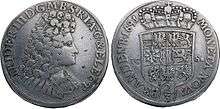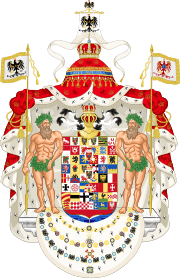Frederick I of Prussia
Frederick I (German: Friedrich I.; 11 July 1657 – 25 February 1713), of the Hohenzollern dynasty, was (as Frederick III) Elector of Brandenburg (1688–1713) and Duke of Prussia in personal union (Brandenburg-Prussia). The latter function he upgraded to royalty, becoming the first King in Prussia (1701–1713). From 1707 he was in personal union the sovereign prince of the Principality of Neuchâtel (German: Fürstentum Neuenburg). He was also the paternal grandfather of Frederick the Great.
Biography
Family
Born in Königsberg, he was the third son of Frederick William, Elector of Brandenburg by his father's first marriage to Louise Henriette of Orange-Nassau, eldest daughter of Frederick Henry, Prince of Orange and Amalia of Solms-Braunfels. His maternal cousin was King William III of England. Upon the death of his father on 29 April 1688, Frederick became Elector Frederick III of Brandenburg and Duke of Prussia. Right after ascending the throne Frederick founded a new city southerly adjacent to Dorotheenstadt and named it after himself, the Friedrichstadt.[1]
Military career
Frederick was noted for his opposition to France, in contrast to his father who had sought an alliance with Louis XIV. Frederick took Brandenburg into the League of Augsburg against France and in 1689 led military forces into the field as part of the allied coalition. That year an army under his command besieged and captured Bonn. Despite this opposition to France (a characteristic that was even more prominent in his son and heir) he was fond of French culture, and styled his court in imitation of that of Louis XIV.[2]
Reign as King

The Hohenzollern state was then known as Brandenburg-Prussia. The family's main possessions were the Margraviate of Brandenburg within the Holy Roman Empire and the Duchy of Prussia outside of the Empire, ruled as a personal union. Although he was the Margrave and Prince-elector of Brandenburg and the Duke of Prussia, Frederick desired the more prestigious title of king. However, according to Germanic law at that time, no kingdoms could exist within the Holy Roman Empire, with the exception of the Kingdom of Bohemia which belonged to the Holy Roman Emperor.
In the Crown Treaty of 16 November 1700, Frederick persuaded Leopold I, Archduke of Austria and Holy Roman Emperor, to allow Prussia to be elevated to a kingdom. This agreement was ostensibly given in exchange for an alliance against King Louis XIV in the War of the Spanish Succession and the provision of 8,000 Prussian troops to Leopold's service. Frederick argued that Prussia had never been part of the Holy Roman Empire, and he ruled over it with full sovereignty. Therefore, he said, there was no legal or political barrier to letting him rule it as a kingdom. Frederick was aided in the negotiations by Charles Ancillon.
Frederick crowned himself on 18 January 1701 in Königsberg. Although he did so with the Emperor's consent, and also with formal acknowledgement from Augustus II the Strong, Elector of Saxony, who held the title of King of Poland, the Polish-Lithuanian Diet (Sejm) raised objections, and viewed the coronation as illegal.[3] In fact, according to the terms of the Treaty of Wehlau and Bromberg, the House of Hohenzollern's sovereignty over the Duchy of Prussia was not absolute but contingent on the continuation of the male line (in the absence of which the duchy would revert to the Polish crown).[3] Therefore, out of deference to the region's historic ties to the Polish crown, Frederick made the symbolic concession of calling himself "King in Prussia" instead of "King of Prussia".[3][4]
His royalty was, in any case, limited to Prussia and did not reduce the rights of the Emperor in the portions of his domains that were still part of the Holy Roman Empire. In other words, while he was a king in Prussia, he was still only an elector under the suzerainty of the Holy Roman Emperor in Brandenburg. Legally, the Hohenzollern state was still a personal union between Brandenburg and Prussia. However, by the time Frederick crowned himself as king, the emperor's authority over Brandenburg (and the rest of the empire) was only nominal, and in practice it soon came to be treated as part of the Prussian kingdom rather than as a separate entity. His grandson, Frederick the Great, was the first Prussian king to formally style himself "King of Prussia".

Frederick was a patron of the arts and learning. The Akademie der Künste in Berlin was founded by Frederick in 1696, as was the Academy of Sciences in 1700, though the latter was closed down by his son as an economic measure; it was reopened in 1740 by his grandson, Frederick II. Frederick also appointed Jacob Paul von Gundling as Professor of History and Law at the Berlin Knights Academy in 1705, and as historian at the Higher Herald's Office in 1706.
Frederick died in Berlin in 1713 and is entombed in the Berliner Dom.
His grandson, Frederick the Great, referred to Frederick I as "the mercenary king", due to the fact that he greatly profited from the hiring of his Prussian troops to defend other territories, such as in northern Italy against the French.[5] "All in all," he wrote of his grandfather, "he was great in small matters, and small in great matters."[6]
Marriages and children
Frederick was married three times:
- first to Elizabeth Henrietta of Hesse-Kassel, with whom he had one child,
- Louise Dorothea, born 1680, who died without issue at age 25.
- then to Sophia Charlotte of Hanover, with whom he had
- Frederick August (1685–1686)
- Frederick William I, born in 1688, who succeeded him.
- In 1708, he married Sophia Louise of Mecklenburg-Schwerin, who survived him but had no children by him.
He also had an official mistress, Catharina von Wartenberg, between 1696 and 1711. However, he was never known to make use of her services, being deeply in love with his first wife.
Ancestry
| Ancestors of Frederick I of Prussia | |||||||||||||||||||||||||||||||||||||||||||||||||||||||||||||||||||||||||||||||||||||||||||||||||||||||||||||||||||||||||||||||||||||||||||||||||||||||||||||||||||||||||||||||||||||||||||||||||||||||||||||||||||||||||||||||||||||||||||||||||||||||||||||||||||||||||||||||||||||||||
|---|---|---|---|---|---|---|---|---|---|---|---|---|---|---|---|---|---|---|---|---|---|---|---|---|---|---|---|---|---|---|---|---|---|---|---|---|---|---|---|---|---|---|---|---|---|---|---|---|---|---|---|---|---|---|---|---|---|---|---|---|---|---|---|---|---|---|---|---|---|---|---|---|---|---|---|---|---|---|---|---|---|---|---|---|---|---|---|---|---|---|---|---|---|---|---|---|---|---|---|---|---|---|---|---|---|---|---|---|---|---|---|---|---|---|---|---|---|---|---|---|---|---|---|---|---|---|---|---|---|---|---|---|---|---|---|---|---|---|---|---|---|---|---|---|---|---|---|---|---|---|---|---|---|---|---|---|---|---|---|---|---|---|---|---|---|---|---|---|---|---|---|---|---|---|---|---|---|---|---|---|---|---|---|---|---|---|---|---|---|---|---|---|---|---|---|---|---|---|---|---|---|---|---|---|---|---|---|---|---|---|---|---|---|---|---|---|---|---|---|---|---|---|---|---|---|---|---|---|---|---|---|---|---|---|---|---|---|---|---|---|---|---|---|---|---|---|---|---|---|---|---|---|---|---|---|---|---|---|---|---|---|---|---|---|---|---|---|---|---|---|---|---|---|---|---|---|---|---|---|---|---|
| |||||||||||||||||||||||||||||||||||||||||||||||||||||||||||||||||||||||||||||||||||||||||||||||||||||||||||||||||||||||||||||||||||||||||||||||||||||||||||||||||||||||||||||||||||||||||||||||||||||||||||||||||||||||||||||||||||||||||||||||||||||||||||||||||||||||||||||||||||||||||
Notes
- Stenzel (1841), Band 3, Buch VI, 2. Hauptstück, p. 406
- Nancy Mitford, "Frederick the Great" (1970) pp. 3.
- Friedrich, Karin (2012). Brandenburg-Prussia, 1466-1806: The Rise of a Composite State. New York: Palgrave Macmillan. p. 66.
- Friedrich, Karin (2006). The Other Prussia: Royal Prussia, Poland and Liberty, 1589-1772. Cambridge: Cambridge University Press. p. 163.
- Spencer, Charles, Blenheim, Chapter 22: Vindication, p.316
- Williams, Ernest Neville (1970). The Ancien Régime in Europe: Government and Society in the Major States, 1648–1789. The Bodley Head. p. 305.
Further reading
- Dwyer, Philip G., ed. The Rise of Prussia, 1700–1830 (2000).
- Frey, Linda, and Marsha Frey. Frederick I: The Man and His Times (1984).
External links

- . Encyclopædia Britannica (11th ed.). 1911.
Frederick I of Prussia Born: 11 July 1657 Died: 25 February 1713 | ||
| Regnal titles | ||
|---|---|---|
| Preceded by Frederick William |
Duke of Prussia 1688–1701 |
Elevation to Kingdom |
| Elector of Brandenburg as Frederick III 1688–1713 |
Succeeded by Frederick William I | |
| New title | King in Prussia 1701–1713 | |
| Preceded by Marie |
Prince of Neuchâtel as Frederick I 1707–1713 | |
| Preceded by William III |
Prince of Orange (disputed) 1702–1713 | |

